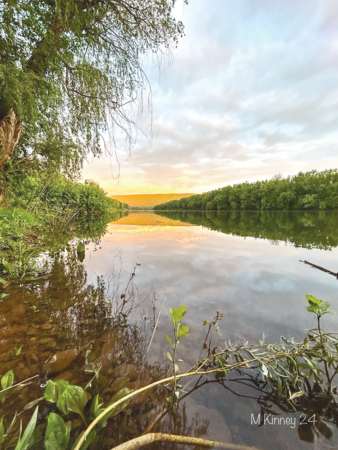Last week, I told you about a friend who was on an adventure. My man, Michael Kinney, is paddling the entire West Branch of the Susquehanna. I reached out to him with a few questions. Unfortunately, Mike had no cell phone service, but he did get back to me a few days later. My article was already submitted. No worries. But his responses were too good not to add. Here is an update from Mike near Hyner.
“Sorry, I had no service. Still want those answers? Taking two days off now that I’m halfway and four days ahead of schedule. I’m paddling 228 miles for three reasons: to raise awareness for river and watershed appreciation, gather more footage for my photography library, and adventure before life gets too old. I’ve pondered the idea for about four years and started planning this past January. It became the most detailed plan I ever had to map out. I am just past halfway now. Resting my arms and feet. The rowing was easier than I thought; the hardest part was walking around heavy debris areas of the headwaters and unloading the canoe to set up camp. I regret not bringing enough rain gear and didn’t expect it to be such a soggy trip. I plan to be passing Williamsport around May 20th to the 22nd. I was worried that my hopes of raising awareness and connecting river towns and watersheds wouldn’t be something I could accomplish, but communities, groups, and people like you have done all that work themselves by reaching out, spreading the word, publishing updates, and following along on my trip.” MICHAEL KINNEY.
Much love, Mike. Safe travels. You have got to see some of his pictures. Great stuff, man. We are all super jealous. Here is another column on paddling.
North Central Pennsylvania is home to several opportunities, and paddling gives you an entirely new perspective. This includes kayaking, canoeing, and even wakeboarding. Many folks are out on the nearby lakes, rivers, and streams. Yes, paddling is another great option to experience the outdoors. Forget the wakeboards. I have no balance.
The Spencers have a canoe, and it is currently in the yard. There was a time when we would use it more. We are getting older. While Mom sits in the back reading her book, Jensen and I are both fishing. We are hoping to get her out for Memorial Day Weekend. It is rather difficult to keep their attention. There are no USB ports in the Saranac 2000. I tend to drive around with our boat tied to the top and strategically park at Wegmans. That guy is cool.
I purchased my first kayak a few years back and am very glad I did. I needed something smaller than the family’s canoe. My little boat fits great, and I am starting to use it more. It’s so lightweight, and I no longer need any assistance getting her on and off the car. It’s my personal Edmond Fitzgerald. Kayaking is very beneficial to both the mind and body. It provides great exercise and another way to enjoy the spectacular scenery of our splendid waterways. From a distance, kayaking seems rather simple. True, but I will say that it is a tad more technical than handling a canoe.
OK, folks. There is no need to buy a kayak before you try it. Paddling isn’t for everyone, and I highly recommend that you borrow a buddy’s boat first. While your friends might be able to get you out on the water, there’s no guarantee they’ll teach you the proper technique. Many rookies develop bad habits that strain their necks and backs. This eventually leaves us discouraged, and we quit. A decent understanding of the basic stroke will ensure your experiences in a kayak go rather smoothly. It’s important to know that the best paddlers use the least amount of energy. Sit up straight and face forward. Keep those hands and wrists in line with your arms. Lightly grip the paddle.
It may seem natural to use just your arms, but the core is much stronger and will help you last a lot longer. Rotate your torso from left to right instead, making sure your back is pressed against the seat at all times. Sitting forward will not only shift your center, but it will also cause you to use more energy. To make a stroke, rotate your body to the right while reaching forward with the left side of the paddle. Simply dip the blade into the water and pull it back firmly while rotating your torso. Remember not to lean forward. When the left blade exits- the right should enter the water on the opposite side of the kayak. Pull back firmly and repeat the process.
It’s best to get started on a quiet lake or lazy river. I highly recommend Rose Valley in the 17728. Most streams and creeks can overwhelm those new to kayaking. Battling the current and avoiding snags shouldn’t be done the first time out. Once you think you are ready — plan a group outing down the Susquehanna or Big Pine Rivers. Coordinating with a few friends makes the put-in and take-out rather easy. There are some exceptional launches in our area.
Be sure to pack plenty of water, snacks, sunscreen, an emergency whistle, and extra layers of clothing. A waterproof drybag is highly recommended and will come in handy if you plan to take your cell phone or camera. Have dry clothes available — especially in the early spring. I always keep a change of clothes inside the car just in case. The most important piece of equipment on any kayaking trip is your Personal Flotation Device. There are several different types of PFDs, but a Type III is the only way to go. You should look for a vest that is comfortable, fits well but not too tightly, and helps you stay afloat. It is required that every kayaker has a PFD in their boat.
Give a hoot. Don’t pollute. Enjoy the outdoors and leave no trace. Hopefully this write-up will get you on the water with me real soon. My friend Michael Kinney has me itching. Cheers.




